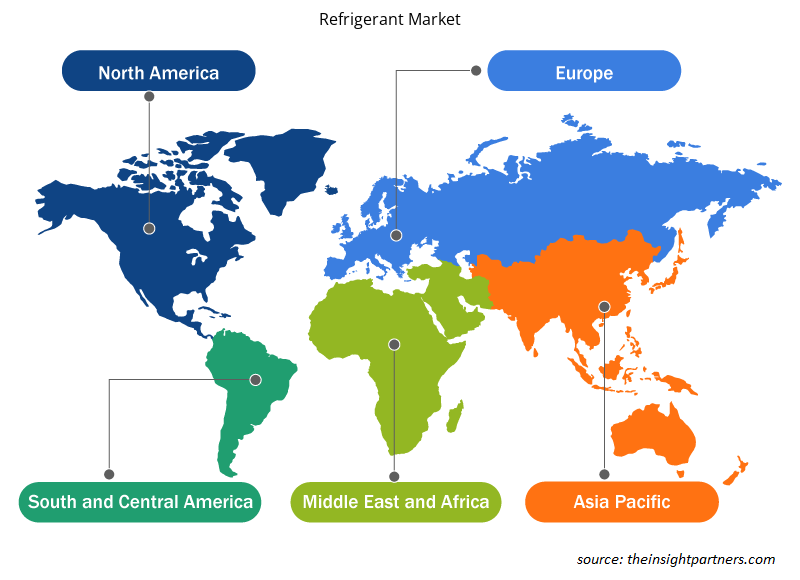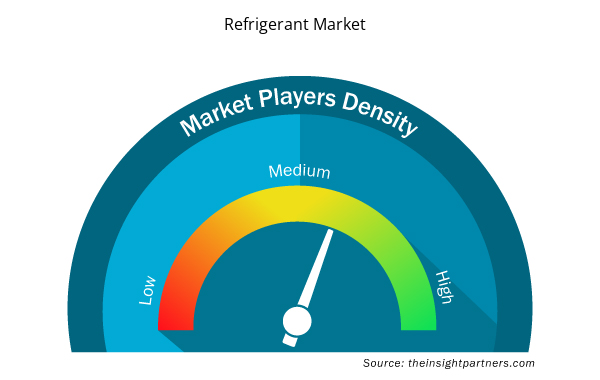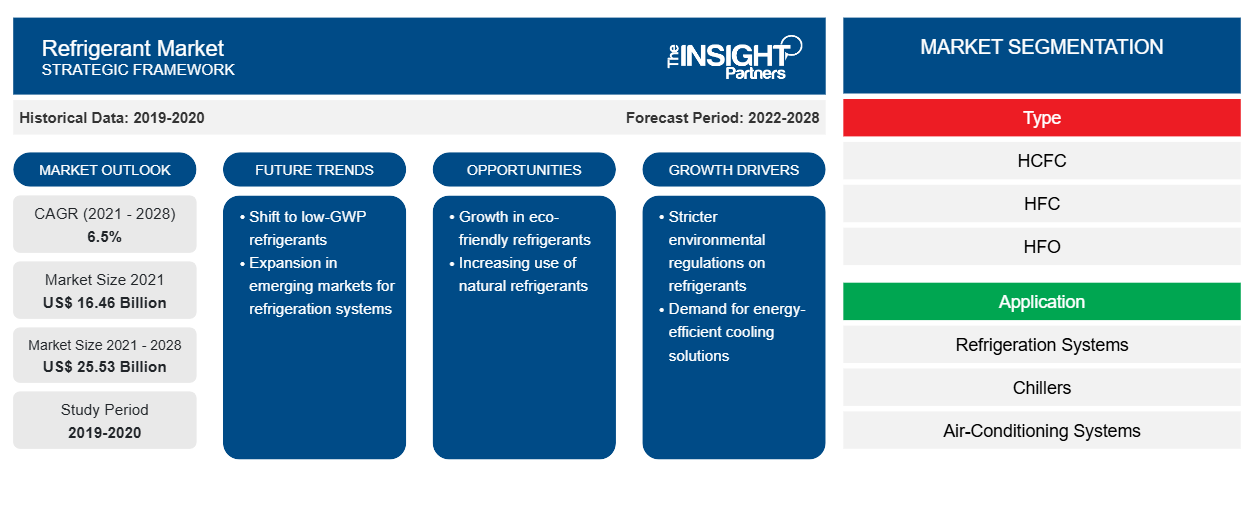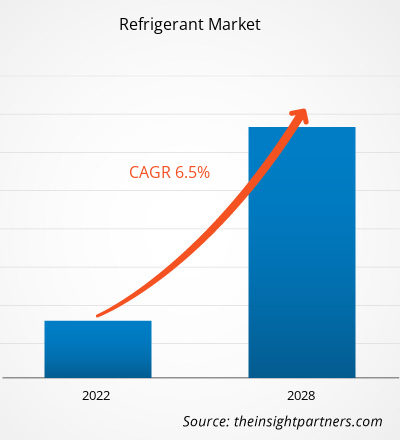[Forschungsbericht] Der Kältemittelmarkt wurde im Jahr 2021 auf 16.458,3 Millionen US-Dollar geschätzt und soll bis 2028 25.534,6 Millionen US-Dollar erreichen; von 2021 bis 2028 wird ein durchschnittliches jährliches Wachstum von 6,5 % erwartet.
Kältemittel ist eine Art Flüssigkeit, die im thermodynamischen Zyklus der Klimaanlage verwendet wird. Das Kältemittel durchläuft im Kühlprozess einen kontinuierlichen Phasenübergang von flüssig zu gasförmig und dann von gasförmig zu flüssig. Kältemittel werden häufig als Kühlmittel in Kühlsystemen, Kühlern und Klimaanlagen verwendet, um Wärme aus der Umgebung aufzunehmen und nach außen zu pumpen.
Im Jahr 2020 hatte der asiatisch-pazifische Raum den größten Umsatzanteil am globalen Kältemittelmarkt . Die hohe Nachfrage nach Kühlsystemen aus gewerblichen und industriellen Sektoren wie der chemischen Verarbeitung, der Lebensmittel- und Getränkeindustrie sowie dem Gesundheitswesen treibt den Markt im asiatisch-pazifischen Raum hauptsächlich an. Darüber hinaus besteht die Region aus Ländern wie Japan, Südkorea, Indien und China, die zu den führenden Herstellern von Kühlsystemen und Klimaanlagen gehören. HFC-Kältemittel werden in industriellen Kühlern aufgrund ihrer perfekten thermischen Stabilität, minimalen Toxizität, Korrosionsbeständigkeit und Nichtbrennbarkeit bevorzugt. Die zunehmende Industrialisierung und Urbanisierung ist auch der Hauptfaktor für die steigende Nachfrage nach Kältemitteln in der Region.
Passen Sie diesen Bericht Ihren Anforderungen an
Sie erhalten kostenlos individuelle Anpassungen an jedem Bericht, einschließlich Teilen dieses Berichts oder einer Analyse auf Länderebene, eines Excel-Datenpakets sowie tolle Angebote und Rabatte für Start-ups und Universitäten.
- Holen Sie sich die wichtigsten Markttrends aus diesem Bericht.Dieses KOSTENLOSE Beispiel umfasst eine Datenanalyse von Markttrends bis hin zu Schätzungen und Prognosen.
Auswirkungen der COVID-19-Pandemie auf den Kältemittelmarkt
Die COVID-19-Pandemie beeinträchtigte die Wirtschaft und Industrie in verschiedenen Ländern durch Lockdowns, Reiseverbote und Betriebsschließungen. Im Jahr 2020 mussten verschiedene Industrien ihren Betrieb aufgrund von Störungen in den Wertschöpfungsketten aufgrund der Schließung nationaler und internationaler Grenzen verlangsamen, was zu einer geringen Nachfrage nach Kältemitteln aus verschiedenen Industrien führte. Die COVID-19-Pandemie führte zu Preisschwankungen bei den zur Herstellung von Kältemitteln benötigten Rohstoffen. Der weltweite Verbrauch von Kältemitteln ging aufgrund der geringen Nachfrage aus verschiedenen Industrien wie dem Baugewerbe und der Fertigung zurück. Die durch die COVID-19-Pandemie verringerte Nachfrage aus verschiedenen Industrien wirkte sich negativ auf das Wachstum des Kältemittelmarktes aus. Es wird jedoch erwartet, dass die Nachfrage nach Kältemitteln weltweit steigen wird, da verschiedene Volkswirtschaften ihren Betrieb wieder aufnehmen.
Markteinblicke
Steigende Nachfrage nach Kühlsystemen
Kühlung ist der wichtigste Prozess in der Industrie und bei Haushaltsgeräten zum Kühlen und Aufrechterhalten der Raumtemperatur. Das Kühlsystem besteht aus vier Hauptkomponenten – Kompressor, Kondensator, Expansionsvorrichtung und Verdampfer. Kühlmittel werden mit Kompressor und Verdampfer kombiniert, um Wärme aus der Umgebung aufzunehmen. Die steigende Nachfrage nach Kühlsystemen in größerem Maßstab in Industrie- und Handelssektoren treibt das Marktwachstum an. Viele chemische Fertigungsindustrien verwenden Kühlsysteme in großem Maßstab für die chemische Verarbeitung. Dies hat zu einem Anstieg des Verbrauchs von Kühlmitteln in industriellen Anwendungen geführt. Beispielsweise wurde während des Aramco-Projekts in Saudi-Arabien HFC-Kältemittel verwendet. Der Boom der Industrialisierung hat zu einer steigenden Nachfrage nach verschiedenen Arten von Kühlmitteln in der Kälte- und Klimaanlagenbranche (RAC) geführt.
Kühlsysteme werden in der großen Kühlkette zur Lagerung und Verteilung von Waren mithilfe von Kühltransportmitteln wie Kühllastwagen, Schienenfahrzeugen, Autos und Containern eingesetzt. Der Fortschritt in der Lieferkettenbranche mit der Einführung von Kühlsystemen zur Aufrechterhaltung der Produktqualität während des Transports hat lukrative Möglichkeiten für den Kältemittelmarkt geschaffen.
Typ-Einblicke
Basierend auf dem Typ wurde der globale Kältemittelmarkt in HFCKW, HFKW, HFO, Isobutan, Propan, Ammoniak, Kohlendioxid und andere segmentiert. Das HFKW-Segment hatte 2020 den größten Marktanteil auf dem Weltmarkt. HFKW werden hauptsächlich in der Kältetechnik, Klimaanlagen, Isolierschäumen und Aerosol-Treibmitteln verwendet , mit kleineren Verwendungszwecken wie Lösungsmitteln und Brandschutz. HFKW-Kältemittel werden auch in Fahrzeugklimaanlagen verwendet. Somit wird der Anwendungsbereich von HFKW für seine Dominanz auf dem Kältemittelmarkt verantwortlich gemacht.
Zu den wichtigsten Akteuren auf dem globalen Kältemittelmarkt zählen The Chemours Company, Arkema, Honeywell International Inc., Linde plc, Air Liquide, Dongyue Group, SINOCHEM GROUP CO., LTD., DAIKIN INDUSTRIES, Ltd., AGC Inc. und Airgas, Inc. Die Akteure auf dem globalen Markt konzentrieren sich ständig auf Strategien wie Investitionen in Forschungs- und Entwicklungsaktivitäten und die Einführung neuer Produkte.
Bericht-Spotlights
- Fortschrittliche Branchentrends auf dem Kältemittelmarkt helfen den Akteuren bei der Entwicklung wirksamer langfristiger Strategien
- In Industrie- und Entwicklungsländern angewandte Strategien für Unternehmenswachstum
- Quantitative Analyse des Kältemittelmarktes von 2019 bis 2028
- Schätzung des weltweiten Bedarfs an Kältemitteln
- Porters Fünf-Kräfte-Analyse zur Veranschaulichung der Wirksamkeit der in der Branche tätigen Käufer und Lieferanten
- Aktuelle Entwicklungen zum Verständnis des wettbewerbsorientierten Marktszenarios
- Markttrend und -aussichten sowie Faktoren, die das Wachstum des Kältemittelmarktes vorantreiben und bremsen
- Unterstützung im Entscheidungsprozess durch Aufzeigen von Marktstrategien, die das kommerzielle Interesse untermauern und zum Marktwachstum führen
- Die Größe des Kältemittelmarktes an verschiedenen Knotenpunkten
- Detaillierte Übersicht und Segmentierung des Marktes sowie der Dynamik der Kältemittelindustrie
- Größe des Kältemittelmarktes in verschiedenen Regionen mit vielversprechenden Wachstumschancen
Regionale Einblicke in den Kältemittelmarkt
Die regionalen Trends und Faktoren, die den Kältemittelmarkt im Prognosezeitraum beeinflussen, wurden von den Analysten von Insight Partners ausführlich erläutert. In diesem Abschnitt werden auch die Marktsegmente und die geografische Lage des Kältemittelmarkts in Nordamerika, Europa, im asiatisch-pazifischen Raum, im Nahen Osten und Afrika sowie in Süd- und Mittelamerika erörtert.

- Erhalten Sie regionale Daten zum Kältemittelmarkt
Umfang des Kältemittelmarktberichts
| Berichtsattribut | Details |
|---|---|
| Marktgröße im Jahr 2021 | 16,46 Milliarden US-Dollar |
| Marktgröße bis 2028 | 25,53 Milliarden US-Dollar |
| Globale CAGR (2021 - 2028) | 6,5 % |
| Historische Daten | 2019-2020 |
| Prognosezeitraum | 2022–2028 |
| Abgedeckte Segmente | Nach Typ
|
| Abgedeckte Regionen und Länder | Nordamerika
|
| Marktführer und wichtige Unternehmensprofile |
|
Dichte der Akteure auf dem Kältemittelmarkt: Auswirkungen auf die Geschäftsdynamik verstehen
Der Markt für Kältemittel wächst rasant, angetrieben durch die steigende Nachfrage der Endverbraucher aufgrund von Faktoren wie sich entwickelnden Verbraucherpräferenzen, technologischen Fortschritten und einem größeren Bewusstsein für die Vorteile des Produkts. Mit steigender Nachfrage erweitern Unternehmen ihr Angebot, entwickeln Innovationen, um die Bedürfnisse der Verbraucher zu erfüllen, und nutzen neue Trends, was das Marktwachstum weiter ankurbelt.
Die Marktteilnehmerdichte bezieht sich auf die Verteilung der Firmen oder Unternehmen, die in einem bestimmten Markt oder einer bestimmten Branche tätig sind. Sie gibt an, wie viele Wettbewerber (Marktteilnehmer) in einem bestimmten Marktraum im Verhältnis zu seiner Größe oder seinem gesamten Marktwert präsent sind.
Die wichtigsten auf dem Kältemittelmarkt tätigen Unternehmen sind:
- Die Chemours Company
- Arkema
- Honeywell International Inc.
- Linde plc
- Air Liquide
Haftungsausschluss : Die oben aufgeführten Unternehmen sind nicht in einer bestimmten Reihenfolge aufgeführt.

- Überblick über die wichtigsten Akteure auf dem Kältemittelmarkt
Globaler Kältemittelmarkt
Typ
- HFCKW
- HFC
- HFO
- Isobutan
- Propan
- Ammoniak
- Kohlendioxid
- Sonstiges
Anwendung
- Kälteanlagen
- Kaltwassersätze
- Klimaanlagen
- MACs
- Sonstiges
Firmenprofile
- Die Chemours Company
- Arkema
- Honeywell International Inc.
- Linde plc
- Air Liquide
- Dongyue-Gruppe
- SINOCHEM GROUP CO., LTD.
- DAIKIN INDUSTRIES, Ltd.
- AGC Inc.
- Airgas, Inc.
- Historische Analyse (2 Jahre), Basisjahr, Prognose (7 Jahre) mit CAGR
- PEST- und SWOT-Analyse
- Marktgröße Wert/Volumen – Global, Regional, Land
- Branche und Wettbewerbsumfeld
- Excel-Datensatz


- Neurovascular Devices Market
- Nurse Call Systems Market
- Online Exam Proctoring Market
- Precast Concrete Market
- Explosion-Proof Equipment Market
- Lyophilization Services for Biopharmaceuticals Market
- Third Party Logistics Market
- Identity Verification Market
- Maritime Analytics Market
- Malaria Treatment Market

Report Coverage
Revenue forecast, Company Analysis, Industry landscape, Growth factors, and Trends

Segment Covered
This text is related
to segments covered.

Regional Scope
North America, Europe, Asia Pacific, Middle East & Africa, South & Central America

Country Scope
This text is related
to country scope.
Häufig gestellte Fragen
The major players operating in the global refrigerant market are The Chemours Company; Arkema; Honeywell International Inc.; Linde plc; Air Liquide; Dongyue Group; SINOCHEM GROUP CO., LTD.; DAIKIN INDUSTRIES, Ltd.; AGC Inc.; Airgas, Inc.
Based on type, the HFC segment accounted for the largest revenue share. HFCs are widely utilized refrigerants in most cooling units across the world.
Growing consumption of eco-friendly refrigerants offers a strong growth opportunity for the refrigerant market in the coming years.
Asia Pacific accounted for the largest share of the global refrigerant market.
The rise in demand for refrigeration systems and an increase in per-capita income in the developing economies are some of the key driving factors for the refrigerant market.
Based on application, the air conditioning system is the fastest-growing segment owing to the increasing use of air conditioning systems in commercial and residential places as they provide cooling or maintain a specific room temperature.
Trends and growth analysis reports related to Chemicals and Materials : READ MORE..
The List of Companies - Refrigerants Market
- The Chemours Company
- Arkema
- Honeywell International Inc.
- Linde plc
- Air Liquide
- Dongyue Group
- SINOCHEM GROUP CO., LTD.
- DAIKIN INDUSTRIES, Ltd.
- AGC Inc.
- Airgas, Inc.
The Insight Partners performs research in 4 major stages: Data Collection & Secondary Research, Primary Research, Data Analysis and Data Triangulation & Final Review.
- Data Collection and Secondary Research:
As a market research and consulting firm operating from a decade, we have published and advised several client across the globe. First step for any study will start with an assessment of currently available data and insights from existing reports. Further, historical and current market information is collected from Investor Presentations, Annual Reports, SEC Filings, etc., and other information related to company’s performance and market positioning are gathered from Paid Databases (Factiva, Hoovers, and Reuters) and various other publications available in public domain.
Several associations trade associates, technical forums, institutes, societies and organization are accessed to gain technical as well as market related insights through their publications such as research papers, blogs and press releases related to the studies are referred to get cues about the market. Further, white papers, journals, magazines, and other news articles published in last 3 years are scrutinized and analyzed to understand the current market trends.
- Primary Research:
The primarily interview analysis comprise of data obtained from industry participants interview and answers to survey questions gathered by in-house primary team.
For primary research, interviews are conducted with industry experts/CEOs/Marketing Managers/VPs/Subject Matter Experts from both demand and supply side to get a 360-degree view of the market. The primary team conducts several interviews based on the complexity of the markets to understand the various market trends and dynamics which makes research more credible and precise.
A typical research interview fulfils the following functions:
- Provides first-hand information on the market size, market trends, growth trends, competitive landscape, and outlook
- Validates and strengthens in-house secondary research findings
- Develops the analysis team’s expertise and market understanding
Primary research involves email interactions and telephone interviews for each market, category, segment, and sub-segment across geographies. The participants who typically take part in such a process include, but are not limited to:
- Industry participants: VPs, business development managers, market intelligence managers and national sales managers
- Outside experts: Valuation experts, research analysts and key opinion leaders specializing in the electronics and semiconductor industry.
Below is the breakup of our primary respondents by company, designation, and region:

Once we receive the confirmation from primary research sources or primary respondents, we finalize the base year market estimation and forecast the data as per the macroeconomic and microeconomic factors assessed during data collection.
- Data Analysis:
Once data is validated through both secondary as well as primary respondents, we finalize the market estimations by hypothesis formulation and factor analysis at regional and country level.
- Macro-Economic Factor Analysis:
We analyse macroeconomic indicators such the gross domestic product (GDP), increase in the demand for goods and services across industries, technological advancement, regional economic growth, governmental policies, the influence of COVID-19, PEST analysis, and other aspects. This analysis aids in setting benchmarks for various nations/regions and approximating market splits. Additionally, the general trend of the aforementioned components aid in determining the market's development possibilities.
- Country Level Data:
Various factors that are especially aligned to the country are taken into account to determine the market size for a certain area and country, including the presence of vendors, such as headquarters and offices, the country's GDP, demand patterns, and industry growth. To comprehend the market dynamics for the nation, a number of growth variables, inhibitors, application areas, and current market trends are researched. The aforementioned elements aid in determining the country's overall market's growth potential.
- Company Profile:
The “Table of Contents” is formulated by listing and analyzing more than 25 - 30 companies operating in the market ecosystem across geographies. However, we profile only 10 companies as a standard practice in our syndicate reports. These 10 companies comprise leading, emerging, and regional players. Nonetheless, our analysis is not restricted to the 10 listed companies, we also analyze other companies present in the market to develop a holistic view and understand the prevailing trends. The “Company Profiles” section in the report covers key facts, business description, products & services, financial information, SWOT analysis, and key developments. The financial information presented is extracted from the annual reports and official documents of the publicly listed companies. Upon collecting the information for the sections of respective companies, we verify them via various primary sources and then compile the data in respective company profiles. The company level information helps us in deriving the base number as well as in forecasting the market size.
- Developing Base Number:
Aggregation of sales statistics (2020-2022) and macro-economic factor, and other secondary and primary research insights are utilized to arrive at base number and related market shares for 2022. The data gaps are identified in this step and relevant market data is analyzed, collected from paid primary interviews or databases. On finalizing the base year market size, forecasts are developed on the basis of macro-economic, industry and market growth factors and company level analysis.
- Data Triangulation and Final Review:
The market findings and base year market size calculations are validated from supply as well as demand side. Demand side validations are based on macro-economic factor analysis and benchmarks for respective regions and countries. In case of supply side validations, revenues of major companies are estimated (in case not available) based on industry benchmark, approximate number of employees, product portfolio, and primary interviews revenues are gathered. Further revenue from target product/service segment is assessed to avoid overshooting of market statistics. In case of heavy deviations between supply and demand side values, all thes steps are repeated to achieve synchronization.
We follow an iterative model, wherein we share our research findings with Subject Matter Experts (SME’s) and Key Opinion Leaders (KOLs) until consensus view of the market is not formulated – this model negates any drastic deviation in the opinions of experts. Only validated and universally acceptable research findings are quoted in our reports.
We have important check points that we use to validate our research findings – which we call – data triangulation, where we validate the information, we generate from secondary sources with primary interviews and then we re-validate with our internal data bases and Subject matter experts. This comprehensive model enables us to deliver high quality, reliable data in shortest possible time.


 Holen Sie sich ein kostenloses Muster für diesen Bericht
Holen Sie sich ein kostenloses Muster für diesen Bericht